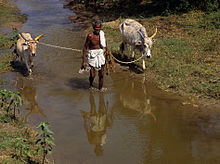Ox

An ox ( Old High German ohso ) is a castrated male cattle .
Word origin
The original meaning of the word is uncertain, especially since in older German ox could be used for both the breeding bull and the castrated male cattle. The word can be compared either with the old Indian ukṣấ “bull”, ukṣáti “sprinkled, moistened”, from which a basic meaning “spattered spatter” or “breeding bull” can be deduced; or with the root word of grow, cf. Old Indian úkṣati “grows”, with which perhaps the “mast ox ” stood at the beginning.
background
Only by means of castration was it possible to use the bull's labor force, which is much greater than that of female cattle, for human purposes. In contrast to the uncastrated male cattle, the bull, an ox could be trained well and was therefore suitable in agriculture as a draft and work animal .
The ox is the oldest documented draft animal. B. Dogs have previously been used for lower loads. The earliest documented use of pairs of oxen in front of the plow took place using a yoke , probably from the middle of the 4th millennium BC. In Central Europe. The chrono-typological evaluation of finds of the Goldberg III group from the Central Franconian gypsum quarry near Marktbergel revealed evidence of the existence of oxen. A little later the ox was pulling rod loops and sledges , and then carts and wagons . Ox carts are still very important in the Third World today. In ox races, the animals are also used as mounts .
In recent years, oxen have been kept increasingly because of their very high-quality, well- marbled meat .
Usually, the castration takes place long before the animals reach sexual maturity, at around a few weeks to a few months of age. Since the growth plates close later in castrated animals , oxen grow significantly longer than bulls and thus reach a size that exceeds that of an ordinary male cattle of the same breed. Oxen are more muscular than cows, but smaller than bulls.
In some countries such as B. in the USA it is common to castrate male animals for pasture fattening , as they are then much more peaceful. The lack of fattening performance is then, if allowed and wanted, often (over) compensated for by injecting hormone capsules into both male and female young animals, so that the animals do not have to be selected by sex for fattening.
Picture gallery
Two oxen in an ecomuseum in Aquitaine (South West France)
An ox cart in Thailand
Device for shoeing oxen
Scenes from ox races in Haunshofen and Langenpettenbach
See also
literature
- Hans-Ulrich Schiedt: Capacities of wagon traffic in the 18th and 19th centuries: Basics of estimating the transport capacities of premodern land transport . In: Laurent Tissot, Christoph Maria Merki , Rainer C. Schwinges , Hans-Ulrich Schiedt (eds.): Traffic history (= Swiss Society for Economic and Social History . Volume 25). Chronos, Zurich 2010, ISBN 978-3-0340-1034-4 , pp. 121-136 ( doi : 10.5169 / seals-309354 ).
- Helmut Schneider : History of ancient technology (= Beck'sche series: Beck Wissen. Volume 2432). 2nd Edition. C. H. Beck, Munich 2012, ISBN 978-3-406-53632-8 , p. 43.
Web links
- Ox fitting
- Farriers shod one of the last working oxen Photo report, Badische Zeitung , June 21, 2009.
Individual evidence
- ↑ See Etymological Dictionary of German. Developed under the direction of Wolfgang Pfeifer. 3 volumes. Akademie Verlag, Berlin 1989; several new editions.
- ↑ Martin Nadler: Animal labor in the Neolithic? - Evidence of oxen in the early Neolithic from Marktbergel, Middle Franconia. In: inhibiting Hofener scripts 3 loop slide, bike and car earlier the question of transport north of the Alps . 2002, ISSN 1437-8620 , pp. 109-110.
- ^ Jürgen E. Walkowitz: Logistics in the Neolithic and Chalcolithic. In: Varia Neolithica IV. 2006, ISBN 3-937517-43-X , pp. 123-151.
- ^ Photographs from 2002 from the cycle Heimat by Andreas Bohnenstengel







